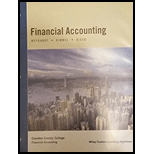
Concept explainers
Journalizing:
Journalizing is the process of recording the transactions of an organization in a chronological order. Based on these journal entries recorded, the amounts are posted to the relevant ledger accounts.
Accounting rules for journal entries:
- To Increase balance of the account: Debit assets, expenses, losses and credit all liabilities, capital, revenue and gains.
- To Decrease balance of the account: Credit assets, expenses, losses and debit all liabilities, capital, revenue and gains.
Worksheet:
A worksheet is a tool that is used while preparing a financial statement. It is a type of form having multiple columns and it is used in the adjustment process. The use of a worksheet is optional for any organization. A worksheet can neither be considered as a journal nor a part of the general ledger. Usually organizations use Microsoft Excel in order to use a worksheet electronically.
It is prepared at the end of an accounting period listing all the ledgers and their balances. The total of the debit balances in the trial balance shall be equal to the total of the credit balances. It is prepared to check whether there is any mathematical error in the accounts.
Adjusted Trial Balance:
Once the adjusting entries are made and posted to the ledger accounts, an adjusted trial balance is prepared. The main purpose of preparing an adjusted trial balance (second trial balance in an accounting cycle) is to check whether the debit and credit balance of the statements after passing the
Income Statements:
Income statement is also known as the
Retained earnings are the profits of the company that are not distributed among the shareholders of the company. These retained earnings are included in the retained earnings statement which are used for the development of the business in the future whenever required.
Classified
In order to improve the ease of understanding, a classified balance sheet is used. In a classified balance sheet, various standard classifications and sections are used to classify all the similar assets and similar liabilities together. The items having similar economic characteristics are put in the same group so that the users of the statement can easily understand the items.
Closing entries:
Closing entries are those journal entries which are passed to transfer the balances of temporary accounts to the permanent accounts. These are passed at the end of the accounting period, to transfer the final balance.
Rules for closing entries:
- Debit the account: All temporary accounts with credit balances.
- Credit the account: All temporary accounts with debit balances
Post-Closing Trial Balance:
It is the statement of trial balance, which is prepared after journalizing the closing entries and posting them to the respective ledgers.
(a)
To Prepare: The journal
a) Journal entries and post the entries to ledgers, (b) Trial balance on worksheet,(c) post adjustments on worksheet (d) Financial statements (income statement, retained earnings statement and classified balance sheet), (e) Journalize and post adjustment entries (f) Journalize and post-closing entries, (g) Post-closing trial balance.
Want to see the full answer?
Check out a sample textbook solution
Chapter 4 Solutions
FINANCIAL ACCOUNTING W/WILEY+ >IP<
- Moonlight Ltd. had 25,000 units of ending inventory recorded at $8.20 per unit using the FIFO method. The current replacement cost is $6.10 per unit. Which amount should be reported as Ending Merchandise Inventory on the balance sheet using the lower-of-cost-or-market rule?arrow_forwardWhat was its charge for depreciation and amortization?arrow_forwardI need the correct answer to this general accounting problem using the standard accounting approach.arrow_forward
- KFC Industries estimates direct labor costs and manufacturing overhead costs for the upcoming year to be $920,000 and $740,000, respectively. KFC allocates overhead costs based on machine hours. The estimated total labor hours and machine hours for the coming year are 23,000 hours and 9,250 hours, respectively. What is the predetermined overhead allocation rate? (Round your answer to the nearest cent.)arrow_forwardCan you help me solve this general accounting question using the correct accounting procedures?arrow_forwardCan you explain the process for solving this financial accounting problem using valid standards?arrow_forward

 AccountingAccountingISBN:9781337272094Author:WARREN, Carl S., Reeve, James M., Duchac, Jonathan E.Publisher:Cengage Learning,
AccountingAccountingISBN:9781337272094Author:WARREN, Carl S., Reeve, James M., Duchac, Jonathan E.Publisher:Cengage Learning, Accounting Information SystemsAccountingISBN:9781337619202Author:Hall, James A.Publisher:Cengage Learning,
Accounting Information SystemsAccountingISBN:9781337619202Author:Hall, James A.Publisher:Cengage Learning, Horngren's Cost Accounting: A Managerial Emphasis...AccountingISBN:9780134475585Author:Srikant M. Datar, Madhav V. RajanPublisher:PEARSON
Horngren's Cost Accounting: A Managerial Emphasis...AccountingISBN:9780134475585Author:Srikant M. Datar, Madhav V. RajanPublisher:PEARSON Intermediate AccountingAccountingISBN:9781259722660Author:J. David Spiceland, Mark W. Nelson, Wayne M ThomasPublisher:McGraw-Hill Education
Intermediate AccountingAccountingISBN:9781259722660Author:J. David Spiceland, Mark W. Nelson, Wayne M ThomasPublisher:McGraw-Hill Education Financial and Managerial AccountingAccountingISBN:9781259726705Author:John J Wild, Ken W. Shaw, Barbara Chiappetta Fundamental Accounting PrinciplesPublisher:McGraw-Hill Education
Financial and Managerial AccountingAccountingISBN:9781259726705Author:John J Wild, Ken W. Shaw, Barbara Chiappetta Fundamental Accounting PrinciplesPublisher:McGraw-Hill Education





